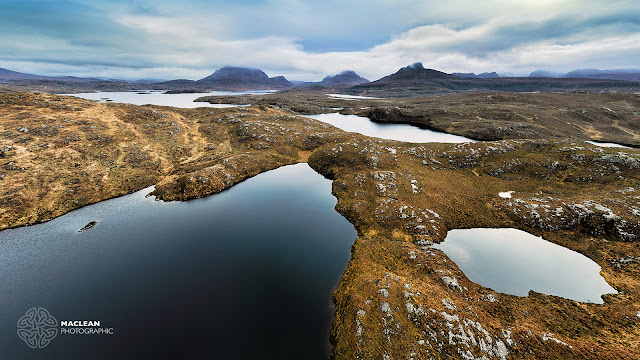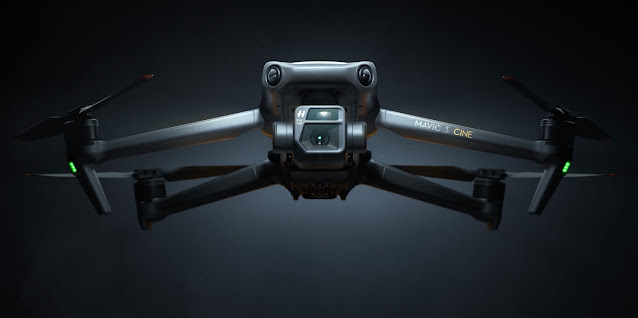Taking Aerial Photographs with the DJI Mavic 3
I have been flying a drone for commercial and personal work since 2018 and have held a Civil Aviation Authority (CAA) Permission for Commercial Operations / Operational Authorisation since April 2019.
In that time I have owned several DJI drones (Mavic Pro, Mavic Air, Phantom 4 Pro, Phantom 4 Pro V2, Mini 2). All of these drones can shoot 4K video which has been used for my clients but, apart from the Phantom, I have never been that happy with the still images coming off these drones.
However, in November 2021, DJI launched the Mavic 3 and, for me as a professional photographer, this is a game changer with regards to capturing aerial photographs with a drone.
I am not going into a full in depth review of the DJI Mavic 3 as there are plenty of technical reviews available since the drone's launch and subsequent firmware update.
However, with it's micro 4/3rds main camera and an additional telephoto camera as well, the Mavic 3 is a big step up from the previous drones. The Hasselblad branded main camera has a 24mm full frame equivalent lens with full manual control of the shutter speed (8-1/8000s), aperture (f2.8-f11) and ISO (100-6400). The camera produces 20mp images (5280-3956 pixels) in RAW and/or JPEG.
The 1/2" sensor secondary camera comes a fixed f4.4 aperture zoom lens and is a first for a prosumer foldable drone. This camera can only be used in auto mode at the present time (hopefully that will change in future firmware updates) and produces 12mp images (4000 x 3000 pixels) in JPEG only.
When it was launched the images from this zoom camera were disappointing, but DJI have improved the firmware and now images up to around 12x zoom are more than acceptable in my professional opinion, but more on that later.
The fact that these cameras are attached to a portable folding drone, capable of 40+ minutes of flight, is even more remarkable.
As I said above, I have owned a Phantom 4 Pro since 2019 but it was big compared to the Mavic series drones and for my work in Europe it was a pain to travel with. I even bought a Pelicase adapted for the drone so it could travel in the aircraft hold. However, after one trip to the Czech Republic to film the Vltava Historic Rally I decided it was too much trouble to use the Phantom 4 abroad.
Last year I shot all my rally footage with a DJI Mini 2 and this was a joy to use as it is small and very portable, but the small camera, with its fixed aperture was a limiting factor, with the still images no better than an average mobile phone.
So when the Mavic 3 was launched I put a deposit down with Clifton Cameras. I ordered the standard Fly More Combo, I decided I didn't need the Cine version of the Mavic 3, which was £2000 more expensive, and the cameras are exactly the same on both models. The standard model comes with the basic RC-N1 controller, so I purchased the RC-PRO controller which has a built in screen and more functionality.
The standard Fly More Combo comes with a set of Neutral Density filters (ND4 - ND32) and are very useful for shooting video. I have order a set of PolarPro Polariser/ND filters which should be more useful for shooting stills and I will report back on those in a further blog.
The first rally I will use the Mavic 3 will be the Rally Costa Brava in Spain next month (17-19 March) but in the meantime I have been shooting landscapes with the drone in and around my home in East Lothian and on a recent trip up to the Highlands.
The Mavic 3 itself is easy to fly and has 360 degree obstacle avoidance sensors. I have seen some crash videos on YouTube and I would never 100% trust the sensors but in my tests they are pretty good at avoiding problems. However, at the end of the day it is the pilots responsibility to avoid objects at all times.
Here are some examples of images taken on the main Hasselblad camera. They are all shot in RAW (.dng) format with full manual exposure control.
 |
| The island of Fidra in East Lothian - 1/100 @ f4.5 ISO100 |
One of the things I noticed straight away when using the new camera was the improved dynamic range and the low light capability. This makes shooting in early morning / late evening light a lot easier. Here are a couple of sunrise shots to demonstrate.
 |
| Sunrise at Yellowcraig, East Lothian - 1/120 @ f8 ISO100 |
 |
| Sunrise at Seacliff, East Lothian - 1/400 @ f2.8 ISO100 |
 |
| Barns Ness Lighthouse - Hasselblad L2D-20c (24mm) - 3x zoom (76mm eq) |
 |
| Barns Ness Lighthouse - DJI FC4170 Camera - 329mm / 11x zoom |
 |
| Tantallon Castle, East Lothian - 1/160 @ f2.8 ISO200 |
 |
| Seacliff Harbour, East Lothian - 1/160 @ f2.8 ISO200 |
 |
| Achnahaird Bay, Highlands - 1/120 @ f4 ISO100 |
 |
| The road near Black Loch - 1/100 @ f4 ISO100 |
 |
| Loch Call nan Uidhean, Highlands, 1/400 @ f2.8 ISO100 |
 |
| The Wailing Widow Falls - 1/25 @ f5 ISO100 |
 |
| Ardvreck Castle, Loch Assynt - 1/100 @ f2.8 ISO100 |
 |
| Highland Beach - 1/240 @ f3.2 ISO100 |






Comments
Post a Comment